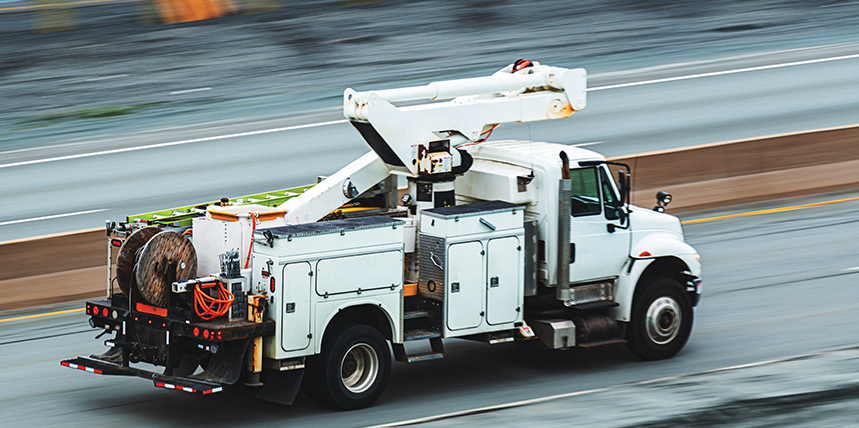Commuting to and from work by vehicle is a daily routine for many. The COVID pandemic has changed how some organizations operate, forcing many employees to work remotely, but for those who need to be on the job doing physical work, the commute never stopped. For some, driving to a jobsite, client sites, the shop, the parts supplier, and everything in between is a work requirement.
Companies sometimes overlook the fact that driving is one of the leading causes of workplace fatalities. According to the Bureau of Labor Statistics, an average of more than 1,000 deaths per year are caused by “roadway incidents involving motorized land vehicles.” That number is significant because just one work-related fatality can have a monumental impact on all aspects of a workplace, including production, insurance costs, and morale.
It is important for companies that have employees who regularly operate a motor vehicle for work purposes to focus on reducing the number of workplace-related roadway incidents. These companies would benefit from developing and administering a driver safety training program as well as programs to manage overall vehicular safety. Several pre-packaged products are available from private companies, or the U.S. Department of Transportation’s guidance can be used to develop your own program.
Training employees in safe driving techniques will reduce the number of vehicular accidents and make the road a safer environment for everybody. The Department of Transportation suggests that basic driving skills should be reinforced for employees who drive company vehicles of all sizes and shapes.
PROPER BACKING
There are many ways to approach proper backing, and no one philosophy is better than the other as long as it is used correctly every time. Training employees on all of these techniques will help decrease the likelihood of a backing incident.
No Backing
Many companies choose to use the no-backing approach. This means that vehicles are driven forward through a parking space, thus allowing them to pull forward out of that space. If they are unable to do that, they may back up into a space upon arrival so they can pull out when they leave.
The advantage to this approach is that the vehicle will not be backing into potential traffic, but away from it, thus avoiding large blind spots that occur when starting the backing maneuver. When backing out of a parking spot, the driver initially has a very limited field of vision that grows larger the farther out of the space the vehicle backs. While pulling forward from the space, the field of vision is fairly large, and it gets even larger as the vehicle pulls out of the space.
Another advantage to backing into the space upon arrival is that the driver gets to look over that space prior to backing in. This prevents backing over something that may be on the ground that could potentially cause damage to the vehicle. If the driver approaches a vehicle from the front to get into the cab and backs out of a space, they will have no idea what is immediately behind or under the vehicle unless they walk to the rear and look, which leads to our second technique.
360-Degree Inspection
A 360-degree inspection is a common technique some companies require and train employees to perform. This technique requires that prior to each and every backing maneuver, the driver (or a spotter) must walk the whole way around the vehicle to ensure that there are no obstructions behind or under it. Some companies even require employees to place cones at the front and rear corners or magnets on each side of the vehicle to enforce this. Sometimes a second person, the spotter, is used to facilitate this technique.
Use a Spotter
Never backing without a spotter is another technique used by companies that require employees to travel together in a vehicle at all times. For this to be effective, strict training must be conducted with both the driver and spotter. There have been many incidents, some fatal, where a spotter has been injured while guiding a vehicle in a backing maneuver. The driver and the spotter must use mutually agreed-upon hand signals like those in Figure 1, since verbal communication may be impossible.

Figure 1: Spotter Hand Signals
Drivers must be trained to stop the vehicle each and every time a spotter is out of sight. One suggested practice is to have the spotter remain in one fixed location on the vehicle (i.e., 5 feet from the driver’s side corner) and never leave that position.
FOLLOWING DISTANCE
Increasing the space between vehicles by creating a wedge gives a driver more time to react. The old Yosemite Sam “Back Off” mud flaps had a message with a purpose. Increasing the space increases the amount of time drivers have to react.
Think of it this way: A vehicle travels 88 feet per second at 60 mph. If it takes a driver one second to see and recognize something, and one second to actually react and hit the brake, the vehicle has travelled 176 feet BEFORE the car starts to stop. That does not even account for factors like vehicle weight or the condition of brakes, tires, roadway surface, etc. All of these can impact how long it takes for the vehicle to stop. Therefore, the greater the distance between vehicles, the easier it is for a driver to react and stop the vehicle in time.
SPEED
“Speed doesn’t kill, it’s suddenly stopping that does,” as the adage goes. Speed is a contributing factor in many accidents. Training drivers to stay within the speed limits (minimum and maximum) helps reduce the likelihood of a crash. It also reduces the severity of a crash should one occur. Considering the tips in the previous section, controlling speed also helps to increase the cushion between vehicles and decreases a vehicle’s stopping distance. Speed reduction does help prevent accidents.
One of the best ways to show someone how going faster doesn’t necessarily get a driver there quicker is by doing this simple math: Two drivers are going 200 miles from point A to point B. They travel the same route; the only difference is the speed they go. Driver A (Joe) drives at 75 MPH, 10 MPH over the posted speed limit. Driver B (Charles) drives at the speed limit, which is 65 MPH. Joe will get to the destination in approximately 2 hours and 40 minutes. Charles will get there in approximately 3 hours.
This is less than a half-hour difference for a 200-mile trip, proving that by going faster, you gain very little time in the grand scheme of things.
REST
The Federal Motor Carrier Safety Administration regulates commercial vehicles and the drivers of those vehicles. They acknowledge that tired driving decreases reaction time (see Following Distance above) and increases the likelihood that a driver may be involved in an accident. Therefore, they strictly regulate the number of hours that may be worked (driving or not) by licensed commercial motor vehicle drivers — and they monitor it closely.
Not everyone will be driving a vehicle that requires a commercial driver’s license, but drowsy driving can still greatly affect reaction time of all drivers. The difference here is that there are no regulations forbidding non-commercial licensed drivers from operating a vehicle when tired. Companies should monitor the hours an employee works, and employees must be trained to self-police and ensure they do not get behind the wheel when drowsy.
DISTRACTED DRIVING
Today, multi-tasking is a fact of life. With the advent of cellular devices, our level of distraction has become increasingly worse. The incessant need for cell phone activity while behind the wheel has hindered our driving safety. Some states have enacted a hands-free-only law, which requires that drivers may talk on the cell phone while driving, but may not physically manipulate it (i.e., text, dial, check emails, etc.). Other states have laws that forbid drivers from talking while operating a vehicle, even when hands-free devices are used. For more information regarding individual state laws, go to www.nhtsa.gov/risky-driving/distracted-driving.
According to the NHTSA website:
Using a cell phone while driving creates enormous potential for deaths and injuries on U.S. roads. In 2019, 3,142 people were killed in motor vehicle crashes involving distracted drivers.
Putting down the cell phone and concentrating on the road increases the possibility that a driver will see something occurring ahead that requires them to react and potentially mitigate a collision or other incident.
CONCLUSION
There are many ways an employee can be injured or worse behind the wheel of a vehicle, whether it be in a company-issued vehicle or their own. By training employees and implementing these safety practices, employers can potentially decrease the chance of their staff becoming a statistic of what has proven to be the leading cause of death in the workplace.
 Paul Chamberlain has been the Safety Manager for American Electrical Testing Co. LLC since 2009. He has been in the safety field since 1998, working for various companies and in various industries. He received a Bachelor of Science from Massachusetts Maritime Academy.
Paul Chamberlain has been the Safety Manager for American Electrical Testing Co. LLC since 2009. He has been in the safety field since 1998, working for various companies and in various industries. He received a Bachelor of Science from Massachusetts Maritime Academy.
